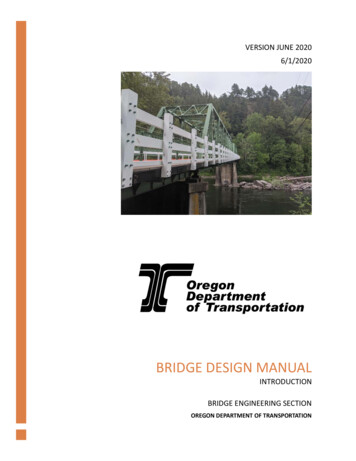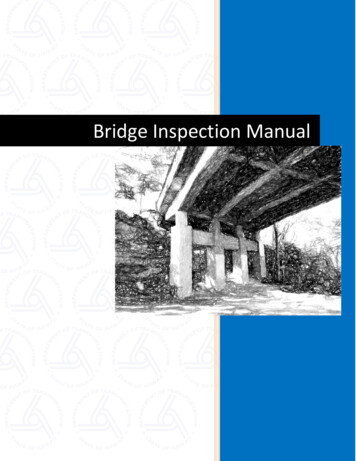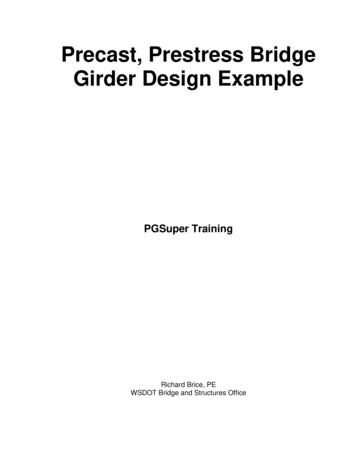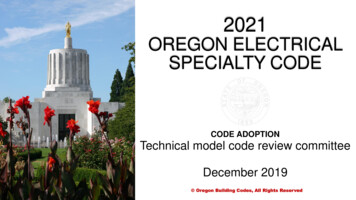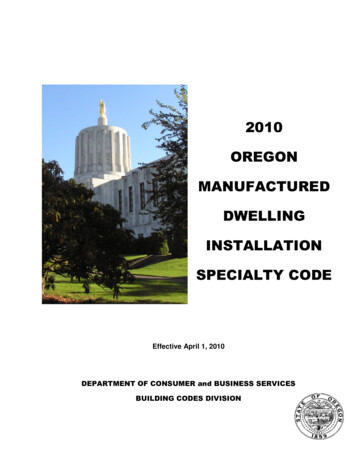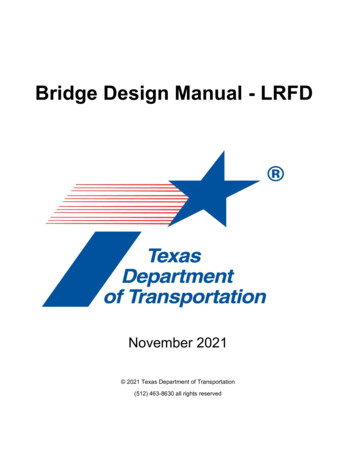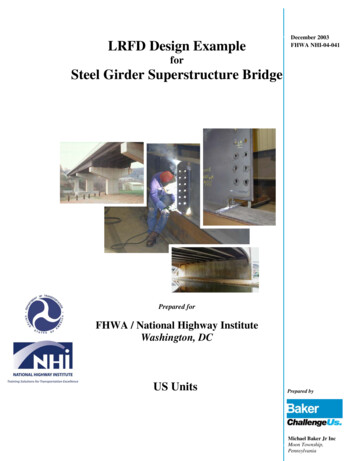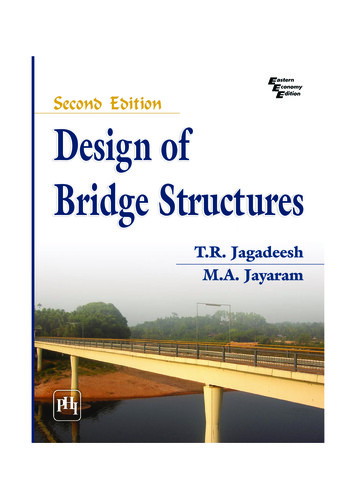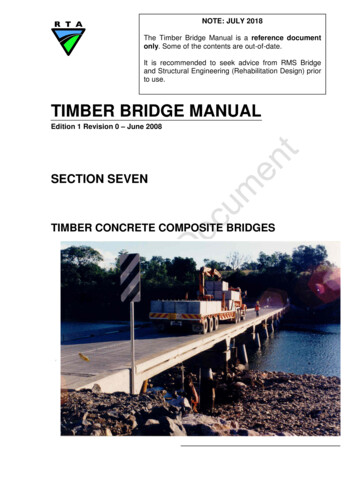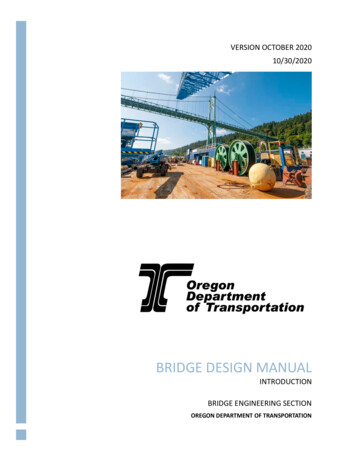
Transcription
VERSION OCTOBER 202010/30/2020BRIDGE DESIGN MANUALINTRODUCTIONBRIDGE ENGINEERING SECTIONOREGON DEPARTMENT OF TRANSPORTATION
Bridge Design Manual – October 2020Oregon Department of TransportationIntroduction / PrefaceTable of ContentsINTRODUCTION . 1Preface . 1Organization of the Manual . 2Revising the Manual . 3Note: Revisions for October 2020 are marked with yellow highlight. Deleted text is not marked; pasteditions of the BDM are available for comparison esign-Manual.aspxINTRODUCTIONPREFACEThe Bridge Design Manual (BDM) provides a reference for those involved in preparing ODOT bridge designdeliverables. The purpose of the manual is to: Provide guidance in design standards and detailing practices (Section 1). Provide guidance in selective design, and bridge type selection and geometric layout (Section2). Provide guidance in bridge design roles and responsibilities, design and quality processes, anditems to coordinate with other disciplines (Section 3).An effort has been made to make the Bridge Design Manual informative, comprehensive, and accurate. It isa guide to acceptable ODOT practices. The manual should be used in the design of State Highway bridges.Use on other bridges in the State of Oregon should only be as noted in this manual, or as directed by thebridge owner.The manual is not a legal document. There is no substitute for sound engineering judgment.Bridge Design Manual users are encouraged to submit comments, corrections, and proposals for new orrevised materials.Any comments or questions about the Bridge Design Manual should be directed to:Bridge Design Standards EngineerOregon Department of TransportationTechnical Services – Bridge Engineering Section4040 Fairview Industrial Drive S.E., MS #4Salem, OR 97302-1142(503) 986-4200Rebecca.BURROW@odot.state.or.usIntro-1
Bridge Design Manual – October 2020Oregon Department of TransportationIntroduction / PrefaceORGANIZATION OF THE MANUALThe Bridge Design Manual is divided into three main sections: Section 1: Design Standards and Detailing Practices Section 2: Design Guidance, Type Selection and Layout Section 3: Processes, RolesThe acronym “BDM” and a number refers to a section, subsection, etc., of this Manual unless anotherreference is specifically called out. So, you will see BDM 2.1, BDM 2.1.1.1(1), etc.The acronym “BCM” and a number refers to a section of the Bridge CAD Manual.The acronym “LRFD” and a number refers to a section of the AASHTO LRFD Bridge Design Specifications.The acronym “SP” and a number refers to a section of the ODOT Construction Specifications.Except for the “Introduction”, each Section has: Main body of text AppendixThe page numbers of the Section’s text are prefixed with the Section number. Thus, for Section 2, the pagenumbers are 2-1, 2-2, etc.The Table of Contents is linked to the Section’s text for Sections 1, 2 and 3. The “Bookmark” navigationfunction is active in all Sections. Also, the “Search” and “Find” functions enable fairly rapid location oftopics.Tables, charts, and examples of forms are all identified as alphanumeric “Figures”. The figure numberrefers to the specific section number where the figure is mentioned: Figure 2.1.1 is the only figure mentioned in Section 2.1.1 and inserted in or closely after theSection 2.1.1 text. Figure 2.1.1A is the first figure of a series of figures mentioned in Section 2.1.1 and inserted in orclosely after the Section 2.1.1 text. Figure A2.3.2A is in the Section 2 Appendix and mentioned in Section 2.3.2.For the sake of brevity or in order to use a familiar term in place of an unfamiliar “official” version, someeditorial liberties have been taken when referring to organizational names or titles:ManualBridge Section or Bridge HQRoadway SectionTraffic SectionRegion Tech CenterOfficialBridge Engineering SectionRoadway Engineering SectionTraffic Management SectionRegional Technical CentersIntro-2
Bridge Design Manual – October 2020Oregon Department of TransportationIntroduction / PrefaceREVISING THE MANUALOnly the Bridge Design Standards and Practices Engineer, BridgeStandards Technical Specialists, or the State Bridge Engineer (orhis/her designee) are to circulate communications concerning matters ofor revisions to design practices.(1) Put It in Writing - Research and develop a written proposal using three general subject headings: Problem Statement Proposal Analysis / Research / and Other Supporting DataA template letter is shown at the end of this Section. An electronic version of this template can be found onthe BDM webpage at ms.aspxComplete your written proposal and submit directly to the Bridge Design Standards and Practices Engineerat the address or email shown in the Preface.(2) Review and Approval - After reviewing a written proposal for completeness, the Design Standards andPractices Engineer will: Acknowledge receipt of the proposal and provide an initial assessment response:o Accepted for consideration as submittedo Accepted for consideration as notedo Proposal tabled, see Remarkso Proposal not accepted, see Remarks For accepted proposals, post the proposal on the BDM webpage and Projectwise Folder forreview and comment.After the review period, responses to comments will be prepared. The Standards Engineer will see that oneof the following is done: Proposals with resolved comments will be included in the BDM. Proposals without resolved comments will be tabled (and possibly reconsidered at a futureupdate should the proposer so elect).Proposals will be forwarded to the FHWA (Federal Highway Administration) for review, comments andapproval. Any FHWA comments on a proposal will be reviewed and given a final approval.(3) Implementation of Approved Revision - After a proposal has final approval, the Standards Engineer willinclude it in the Manual update on the Bridge Engineering web page. Revised or added text will behighlighted in yellow. If a revision is urgent, it may be distributed immediately in a Technical Bulletin andincorporated into the BDM later.Intro-3
Bridge Design Manual – October 2020Oregon Department of TransportationIntroduction / PrefaceTECHNICAL SERVICESO D O T B R I D G E D E S I G NM A N U A LR E V I S I O N R E Q U E S TBridge Engineering SectionOffice Phone: (503) 986-4200Fax Number: (503) 986-3407DATE:Month XX, 20XXTO:Rebecca BurrowBridge Design Standards EngineerFROM:[Name][Position Title][Firm]SUBJECT:Proposed Revision to Bridge Design ManualRE:BDM Section x.x.x.x –Phone#:P roblem Statem ent:P roposal:Modify/Add Section x.x.x.x as follows:Intro-4xxx-xxx-xxxx
Bridge Design Manual – October 2020Oregon Department of TransportationIntroduction / PrefaceAnalysis / R esearch / Other Supporting Data:NoneAttached:Bridge Engineering Section R esponse:Accepted for consideration as submittedProposal tabled, see RemarksAccepted for consideration as notedProposal not accepted, see RemarksRemarks:[Name of Author][Title of Engineer Author]Date[Name of Reviewer]Bridge Design Standards ReviewerDateCc:fileIntro-5
VERSION OCTOBER 202010/30/2020BRIDGE DESIGN MANUALSECTION 1: DESIGN STANDARDSBRIDGE ENGINEERING SECTIONOREGON DEPARTMENT OF TRANSPORTATION
Bridge Design Manual – October 2020Oregon Department of TransportationSection 1 – Design StandardsTable of Contents1.1Section 1 – Introduction . 51.2Bridge Design, General . 61.2.11.2.21.2.31.2.41.3Bridge Design Standards . 6Bridge Design Deviations (DD) and Roadway Design Exceptions (DE) . 7Bridge Design Deliverables . 8Bridge Design Procedures . 10Loads and Distributions . 111.3.11.3.21.3.31.3.41.3.51.3.61.3.71.4Dead Loads . 11Live Loads . 12Sidewalk Loading . 17Vehicular Collision Forces: CT . 18Change in Foundations Due to Limit State for Scour . 21Thermal Forces . 21Wind Load . 21Structural Analysis . 221.4.11.4.21.5Ductility, Redundancy and Operational Importance (LRFD 1.3.3, 1.3.4 & 1.3.5) . 22Shear Correction Factor for Skewed Girders . 22Concrete. ete, General . 23Concrete Finish . 24Concrete Bonding Agents . 26Curing Concrete . 26Reinforcement . 27Precast Prestressed Concrete Elements . 46Cast-In-Place Superstructure . 57Post-Tensioned Structures . 62Camber Diagrams . 70Pour Schedules . 72Steel Structure Design and Detailing . 76Structural Steel, General . 76Structural Steel, Design . 79Welding. 103Galvanizing and Painting . 108Bolts and Connections . 112Aluminum. 114Aluminum . 114Timber Bridge Design and Detailing . 115Timber Bridge Locations . 115Timber Design and Details . 115Timber Connections . 116Timber Rails . 116Preservative Treatments . 116Field Installation. 116Decks . 117Design and Detailing . 117Deck Screeding . 128Deck Construction Joints . 129Deck Overlays . 1301-1
Bridge Design Manual – October 2020Oregon Department of TransportationSection 1 – Design Standards1.10Foundation Considerations. 1411.10.11.10.21.10.31.10.41.10.51.11Substructures . 1811.11.11.11.21.11.31.12Americans with Disabilities Act Compliance for Bridge Projects . 254General Guidance . 254Work Activity Triggers . 255Design Considerations . 258Seismic Design. 81.18Soundwalls, General . 253Soundwalls mounted on Bridges . 253ADA Compliance for Bridge Work . 2541.16.11.16.21.16.31.16.41.17Bearings . 238Expansion Joints . 246Soundwalls. 2531.15.11.15.21.16Bridge Rail . 213Bridge Rail Replacement & Retrofit Guidelines . 225Impact Attenuators or Crash Cushions . 231Protective Screening or Protective Fencing . 231Bearings and Expansion Joints . 2381.14.11.14.21.15Culvert Design, General . 212Tunnels (structural elements) . 212Rails, Impact Attenuators, and Protective Screening . 2131.13.11.13.21.13.31.13.41.14Retaining Structures, General . 181End Bents . 181Interior Bents . 198Buried Structures . 2121.12.11.12.21.13Foundations, General. 141Lateral Earth Restraint . 141Underwater Construction . 142Foundation Modeling (Foundation Springs) . 143Foundation Design . 160Design Philosophy . 260Applications of AASHTO LRFD Bridge Design Specifications . 261Applications of AASHTO Guide Specs for LRFD Seismic Bridge Design . 271Liquefaction Evaluation and Mitigation Procedures . 277Costs . 279Instrumentation . 279Dynamic Isolators. 280Seismic Restrainer Design (New Designs and Retrofits) . 280FRP Composites. 2851.18.1FRP Composites . 2851.19(Reserved). 2861.20Concrete Anchors . 2871.20.11.20.21.21Anchor Bolts / Rods . 287Post-Installed Anchors . 288Structural Wire Rope (Cables) and Turnbuckles. 2941.21.11.21.21.21.31.21.4Structural Wire Rope (Cables) and Turnbuckles, General . 294General Notes for Structural Wire Rope, Turnbuckles and Connections . 295Special Provisions for Wire Rope . 296Special Provisions for Turnbuckles and Socket Connections . 2971-2
Bridge Design Manual – October 2020Oregon Department of TransportationSection 1 – Design Standards1.21.5Design Properties. 2971.22(Reserved). 2981.23Bridge Approach Slabs (End Panels), and Slope Paving . 2991.23.11.23.21.23.31.24Bridge Drainage . russ and Monotube Cantilever Sign Bridges, General . 320Bridge Raising . 3211.29.11.29.21.29.31.30Traffic Structures Mounted on Bridges, General . 319On-Bridge Sign Mounts . 319On-Bridge Illumination Mounts . 319Truss and Monotube Cantilever Sign Bridges . 3201.28.11.29Marine Environment . 312Marine Environment Protection . 312Deck and Approach Slabs Reinforcement Protection. 312Waterproofing Membranes . 315Protection for Steel Piling . 316On-Bridge Sign & Illumination Mounts . 3191.27.11.27.21.27.31.28General Requirements . 307Design and Detailing Guidelines . 308Providing for Utility Installations . 309Special Utility Considerations . 310Attachments to Existing Bridges . 311Utility Costs and Agreements . 311Corrosion Protection . 3121.26.11.26.21.26.31.26.41.26.51.27General, Bridge Drainage . 302Standard Design/Drawing/Details . 302Selection Guidance . 302Design Code Guidance . 302Design Guidance & Lessons Learned . 303Detailing . 304Construction . 306Utilities . 3071.25.11.25.21.25.31.25.41.25.51.25.61.26Bridge Approach Slabs and Supports . 299Skewed Bridge Approach Slabs . 300Slope Paving/Railroad Slope Protection . 301Bridge Raising, General . 321Bridge Raising Using Falsework . 321Bridge Raising Using Chip-in Method . 321Strengthening of Bridges. 3221.30.11.30.2Strengthening of Bridges, General. 322Strengthening Methods and Details . 3231.31(Reserved). 3271.32Preservation and Repair . 3281.32.11.33Preservation and Repair . 328Bridge Paint . 3291.33.1Bridge Paint . 3291.34(Reserved). 3301.35Covered Bridges. 3311-3
Bridge Design Manual – October 2020Oregon Department of TransportationSection 1 – Design Standards1.35.11.36Covered Bridges . 331Moveable Bridges . 3321.36.1Moveable Bridges . 3321.37(Reserved). 3331.38Bridge Temporary Works. n . 334Temporary Detour Bridges . 335Agency Provided Temporary Detour Bridge . 337Falsework . 337Shoring . 340Cofferdams. 340AP P ENDI X – SECTI ON 1 – Glossary . 346AP P ENDI X – SECTI ON 1 – Abbreviations (I nitialism s and Acronym s) . 366AP P ENDI X – Section 1.2 – AASHTO/ BDM Cross-Reference. 377AP P ENDI X – Section 1.11 – Substructures . 383A1.11.1.7A1.11.2.2End Bent Details for Prestressed Slabs and Boxes . 383Interior Bent Details for Prestressed Slabs and Boxes . 388AP P ENDI X – Section 1.20.2.2 – Resin Anchor design . 3911-4
Bridge Design Manual – October 2020Oregon Department of TransportationSection 1 – Design StandardsNote: Revisions for October 2020 are marked with yellow highlight. Deleted text is not marked; past editionsof the BDM are available on the Bridge Engineering Section website for comparison.1.1SECTION 1 – INTRODUCTIONBDM Section 1 contains standards and practices pertinent to highway bridges and structures design.See BDM Section 2 for design guidance pertinent to highway bridges and structures design.See BDM Section 3 for standards and practices pertinent to design procedures and quality processes forcompleting highway bridge and structure design.See Bridge CAD Manual (BCM
Bridge Design Manual should be directed to: Bridge Design Standards Engineer . Oregon Department of Transportation . Technical Services – Bridge Engineering Section . 4040 Fairview Industrial Drive S.E., MS #4 . Salem, OR 97
